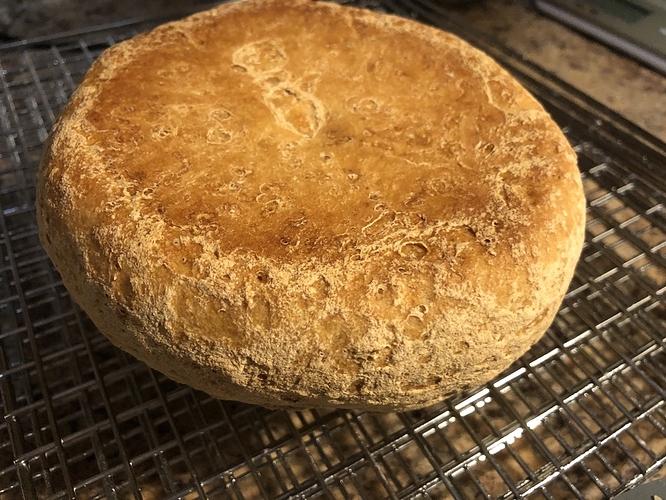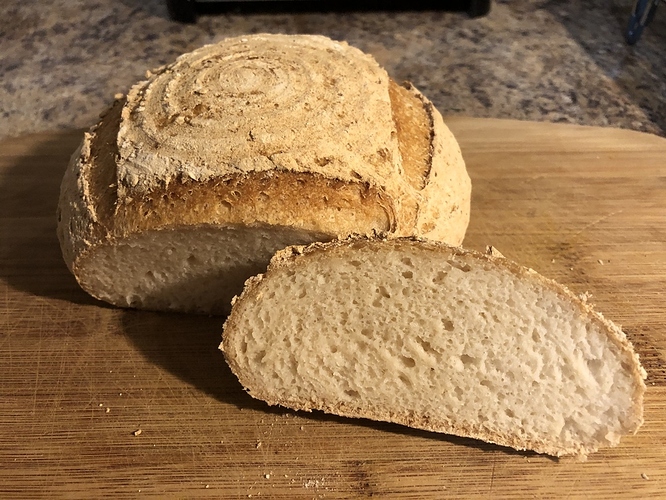Hi Dan,
It looks a little bit like when a cake or quick bread falls in the middle because it’s underdone. In that scenario, the bread would look fine and then start to sag as it cools.
Is that how it plays out?
Are you taking the internal temperature of the bread before you decide it’s done?
If instead the bread is kind of never rising in the middle then I would lean toward over proofed or overhydrated. But that’s really me hazarding a guess because I’ve never pushed this dough very far in the proofing or hydration.
Hi, Melissa,
It seems to fall after I take it out. I also am new to GF baking so not really sure how much it should rise before baking. Unfortunately, my thermometer isn’t functioning right now and I need to fix/replace it!
So, I already am baking it longer than called for, so maybe I should increase the temperature to 425 or 450?
Thanks for your help!
-Dan
I dabbled a bit I to gluten free baking a little while back. Took me some time to get consistent good results. Once I learned what to expect, and that meant doing away with everything I expected from baking with gluten, I managed to get a good feel it. I’m back onto gluten but thought I might chime in with some observations.
1: it looks like you’re baking in a loaf pan that’s too big for the dough size. If you’re going down the loaf pan route then even if you get the hydration a bit off the pan should be able to support it for a better rise. That means filling it more or using a smaller pan.
2: I once managed to ruin a good loaf by taking it out too early. It looked baked on the outside and when I took it out it sank. I thought I’d ruined the recipe from much earlier on however when I cut into it the dough wasn’t baked through properly. It was annoying as it did have potential to be a good loaf and I ruined it at the last moment.
3: a little trial and error may be needed. Perhaps a bit lower hydration and/or baking it a but earlier in case you’re over proofing and/or baking for longer. If its done on the outside but not so in the middle then lower temps for longer may be needed.
I’d love to get my hands on this four to try it myself sometime but I live in the UK so not feasible.
I think you could increase the bake time and temp a bit, and cover it for longer with foil so it doesn’t brown too much.
Has anyone tried variations on this basic version, like a seeded loaf or cranberry walnut? Imagine it would be easy enough to add the new ingredients during the kneading process.
Who’s ventured out a bit?
There is no salt in this recipe. Is that intentional?
@schillingly I don’t know if the recipe below is the recipe you’re using, but it does call for salt at the end of the ingredient list, about 10g or 2 tsp.
Baking blessings,
Leah
I just pulled my first GF loaf from the oven, based on this recipe but using soy/oat milk and cultured almond butter since I don’t eat dairy. Too hot to try slicing yet but it looks beautiful. Attached photos to show results.image|666x500
I used Miyoko cultured almond-based nondairy butter and it worked great!
I made this with soy/oat milk I made myself, and Miyoko brand non-dairy butter made from cultured almonds. Worked great. Eric has posted that he used only water at times, and it worked fine so I will try that another time.
Wow that looks awesome.
Made this bread several times and it always turns out great, thanks for the excellent recipe (and flour!). I’m interested in possibly trying to modify this into a cinnamon raisin bread, similar to the sourdough cinnamon raisin bread on the breadtopia website. Would it work to substitute the sugar for maple syrup, and then adjust the water level? From what I’ve ready, pure maple syrup is about 34% water, so if I swapped it directly for the 24g of sugar, that would mean reducing the water to about 186g (if my math is right). Or would another ratio work better? and would any other adjustments need to be made in light of the cinnamon and raisins, or could they essentially be added to the recipe as is?
I would start with your math but be prepared to go with the flow based on how the dough feels. That’s of course complicated by the fact that raisins absorb liquid from the dough.
You could pre-soak the raisins and actually use math to measure how much water they absorb. Then the next time you’re making the dough you can skip the soak and just use that much extra water in the dough.
Cinnamon inhibits fermentation a bit so beware that your timing may be a little bit slower.
I have been baking artisan breads using Breadtopia recipes and baking tools for years. All the recipes turn out delicious. But, now I find it so difficult to find a recipe that I can use. You see, both my daughter and husband are gluten and dairy sensitive, so I can’t use wheat, eggs or butter. I was so happy to see the Artisan Style Gluten Free Bread recipe on your website, but it contains butter. Is there a substitute? Thanks, Mary
Hi. Would love to try this for my son who has Crohn’s and finds gluten irritating. Was wondering if one could substitute some milled oat groats for some of the flour, or are the flour ingredient combinations needed for this bread to work? If possible, how else should I change the recipe to help it keep it’s shape.
Thank you.
Anybody interested in Baker’s percentage… here it is:
GFBF: 100%
Instant Yeast: 1.33% (.0133)
Sugar: 8% (.08)
Unsalted Butter: 14% (.14)
Water: 65% (.65)
Milk: 43.33% (.4333)
The GFBF already had salt in it.



